

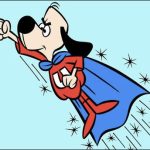
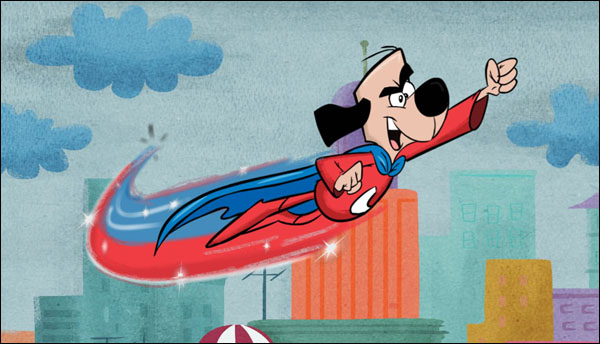
“When criminals in this world appear/And break the laws that they should fear/And frighten all who see or hear/The cry goes out both far and near/For Underdog!”
When the pounding melody of that theme song was heard, generations knew that both a hero and a favorite show were on their way.
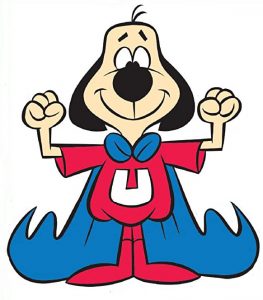 Underdog!
Underdog!
This classic animated TV show celebrates its 60th anniversary this year. The popular series began life at the New York advertising agency Dancer Fitzgerald Sample when VP Account Supervisor W. Watts Biggers partnered with ad executives Chet Stover, Treadwell D. Covington, and artist Joe Harris to create TV shows that would be sponsored by one of the agency’s clients, General Mills.
One of these shows was Underdog. “We were talking about a character that would be a super dog or a super chicken,” remembered Harris in a 1997 interview. “We decided on a super dog, and one of the guys came up with the idea of Underdog.“
Harris, who we sadly lost in 2017, also remembered how the character evolved from his initial concept: “I sat down and drew Underdog, and he looked very much like what you now see, except that he was a lot more sophisticated. He had white hair in the hero style, and it was combed back, and he was a smart guy. They said, ‘No, we need someone more vulnerable.’ So, gradually, the character’s visual imagery and the writing came together, and, in a few days, we created what is the current Underdog.”
Debuting on CBS on October 3, 1964, Underdog was produced by Total Television (which was co-founded by Harris, Stover, Biggers and Covington) the animation studio behind two other TV hits of the time, King Leonardo and His Subjects and Tennessee Tuxedo and his Tales. With Underdog, the studio took the superhero paradigm and made its own, adding touches of parody, reverence, and sharp humor that made the show a favorite.
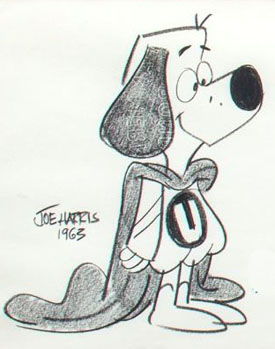 The show’s title character is the alter ego of the Clark Kent-like, mild-mannered and self-explanatory Shoeshine Boy. But, when a villain threatens Capital City, the meek, bespectacled Shoeshine Boy finds the nearest phone booth and transforms into Underdog. Sporting a blue cape and striking red costume emblazoned with a “U” on its front, he would fly off to do battle, speaking in rhyme: “There’s no need to fear! Underdog is here!”
The show’s title character is the alter ego of the Clark Kent-like, mild-mannered and self-explanatory Shoeshine Boy. But, when a villain threatens Capital City, the meek, bespectacled Shoeshine Boy finds the nearest phone booth and transforms into Underdog. Sporting a blue cape and striking red costume emblazoned with a “U” on its front, he would fly off to do battle, speaking in rhyme: “There’s no need to fear! Underdog is here!”
Sweet Polly Purebred, another canine, was a Lois Lane-like TV news reporter who would report on Underdog’s efforts and wind up being rescued by him, especially after singing, (to the tune of “Where oh where has my little dog gone”), “Where oh where has my Underdog gone?”
In most episodes, Underdog would face off against his two main rivals, the villains Riff Raff and Simon Bar Sinister. Riff Raff was a wolf gangster who led a team of thugs, while Simon Bar Sinister was a mad scientist who carried out his plans with his assistant, Cad Lackey.
The multi-talented actor Allen Swift provided the voices for both villains, employing a George Raft impression for Riff Raff and a Lionel Barrymore voice with Simon Bar Sinister. The cast also included actress Norma MacMillan as Sweet Polly Purebread, Ben Stone as Cad, and George S. Irving as the show’s narrator.
The voice of Underdog was provided by comedian Wally Cox, whose meek, mild persona was well known from the popular sitcom Mister Peepers, which ran from 1952-1955. “His voice was perfect for Underdog,” said Harris, in 1997, of Cox. “But, I don’t think that it influenced the character. I think the character was created, and Wally was the perfect avatar for that character. His voice matched the characteristics of the character. I think the casting of the character was done first, and then Wally was the embodiment of the character.”
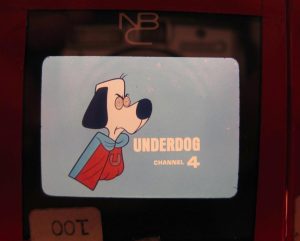 On the show, the adventures of Underdog were split up into parts, similar to the “cliffhanger” serials of yesteryear. Several of the show’s supporting segments were changed when Underdog eventually transitioned to syndication. Some of the segments included The World of Commander McBragg, where a retired British Commander would relay his outlandish adventures, and Tennessee Tuxedo, who, with his pal Chumley the walrus, found ways to escape from the zoo.
On the show, the adventures of Underdog were split up into parts, similar to the “cliffhanger” serials of yesteryear. Several of the show’s supporting segments were changed when Underdog eventually transitioned to syndication. Some of the segments included The World of Commander McBragg, where a retired British Commander would relay his outlandish adventures, and Tennessee Tuxedo, who, with his pal Chumley the walrus, found ways to escape from the zoo.
Underdog was extremely popular, running from 1964-1967 and enjoying a healthy life in syndication afterward. The character appeared on numerous pieces of merchandise, and audiences eventually knew the show’s familiar lines by heart.
“By the time Underdog came along, we had already done King Leonardo and Tennessee Tuxedo,” recalled Harris in ‘97. “They were top-rated daytime shows, so we’d gotten our feet wet. When Underdog came along, it didn’t really surprise us that he went to the top 10. What surprised us was the popularity and the way kids picked up on the phrase.”
 Underdog also soared to new heights of popularity when he became a famous part of Macy’s Thanksgiving Day Parade as a balloon in 1965. Harris partnered with Macy’s on the design and remembered that this was his first sense that the success of Underdog had exceeded the creators’ expectations: “When Macy’s said, ‘Can you design a balloon?’ I thought, ‘Boy, we hit the big time.’ That was my first inkling that was something beyond what I had been doing before.”
Underdog also soared to new heights of popularity when he became a famous part of Macy’s Thanksgiving Day Parade as a balloon in 1965. Harris partnered with Macy’s on the design and remembered that this was his first sense that the success of Underdog had exceeded the creators’ expectations: “When Macy’s said, ‘Can you design a balloon?’ I thought, ‘Boy, we hit the big time.’ That was my first inkling that was something beyond what I had been doing before.”
Underdog would remain a part of the parade for almost twenty years and was even the subject of a famous Thanksgiving episode of the blockbuster sitcom Friends in 1994, where the balloon becomes untethered and floats across the city.
It’s just one example of the long-lasting appeal of Underdog, who has rightly become a beloved icon of television animation.
Mark Arnold, author of the books Created and Produced by Total Television Productions and The Total Television Productions Scrapbook, credits Underdog’s popularity to the creative team who initially crafted the series: “I feel Underdog, as with all TTV productions, had a different style and feel to them possibly because creators Buck Biggers, Chet Stover, Joe Harris, and Tread Covington had an advertising background so the impetus was to create characters and situations and taglines that were memorable in the same way as a good advertising campaign sticks in the mind.”
Sixty years later, fans don’t have to worry if they need a nostalgic fix of classic television animation; all they need to listen for is the heroic call: “There’s no need to fear, Underdog is here!”